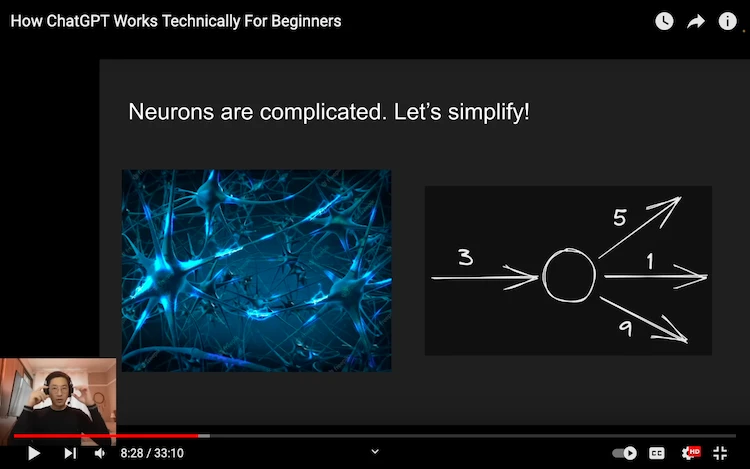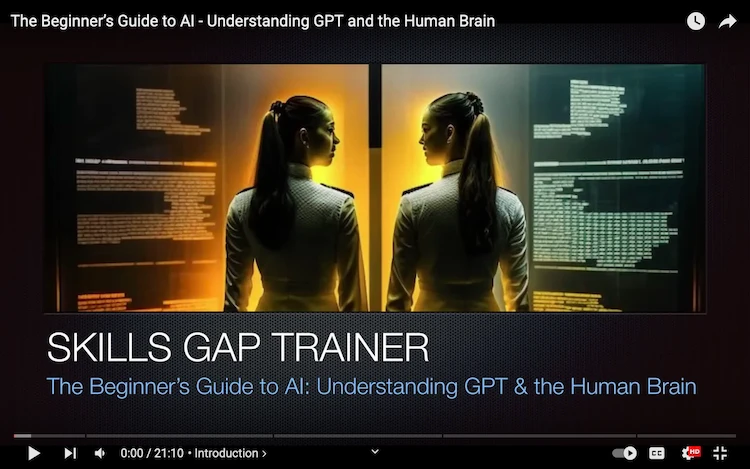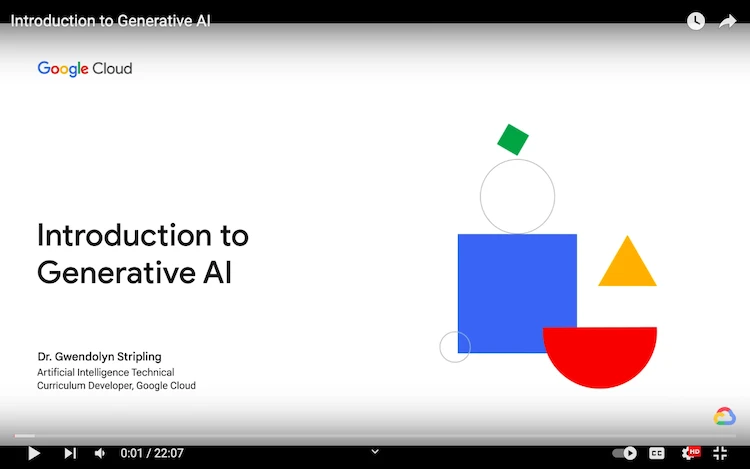Video: How ChatGPT Works Technically For Beginners
YouTube Link: https://youtu.be/uCIa6V4uF84
Video: The Beginner’s Guide to AI – Understanding GPT and the Human Brain
YouTube Link: https://youtu.be/ZQdMUiK979g
Introduction
If there’s one journey that can illuminate the infinite possibilities of our collective future, it’s venturing into the enigmatic realms of Artificial Intelligence (AI) and the human brain. This report is your personal map through these fascinating territories, a voyage inspired by the insightful explorations of the widely acclaimed Kurdiez.
Our journey begins in the first section, where we explore the intriguing terrain of AI, stopping to admire its varied landscapes – from the simplicity of narrow AI to the envisioned complexity of superintelligent AI. Then, we delve into the intricate architecture of neural networks, the very lifeblood of AI systems, dissecting their structure, functionality, and training process.
In the second section, our expedition takes us through the vast expanses of large language models. Much like intrepid explorers, we aim to decode the enigma of these AI wonders, journeying from their foundational principles to the complex mechanisms that fuel their ability to manipulate human language with breathtaking finesse.
Our exploration culminates in a compelling third section, where we embark on an audacious comparative study between AI and the grandest enigma of all – the human brain. With its trillions of interconnections, the brain’s labyrinth presents us with captivating contrasts and similarities to AI. As we traverse this section, we’ll question, understand, and envision how further deciphering the brain’s mysteries can guide the future course of AI.
As Kurdiez wonderfully captures in his videos, the fusion of AI and neuroscience is a powerful confluence, pushing the boundaries of what we know, and propelling us into a future that’s unfolding right before our eyes. So, are you ready for this voyage of discovery?”
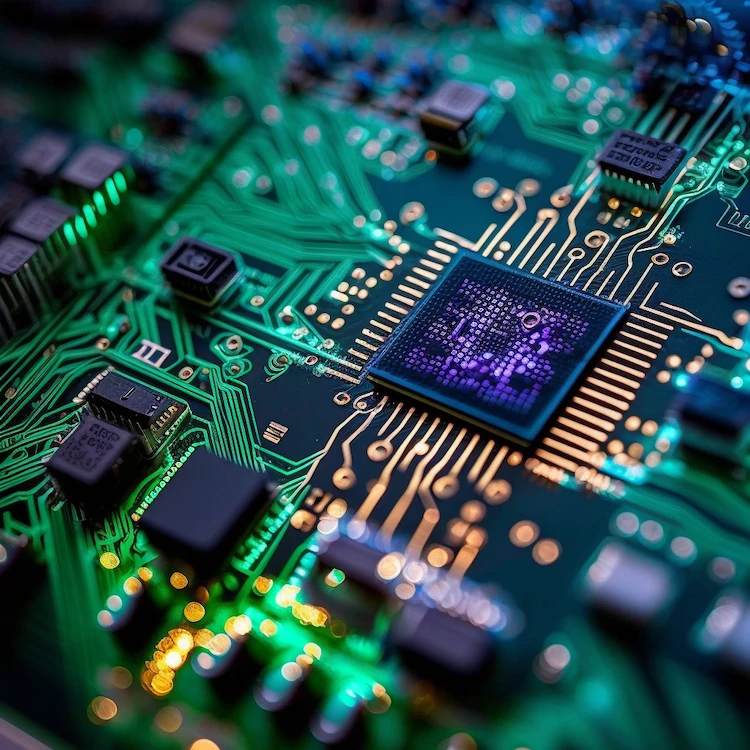
Part 1: Understanding AI and Neural Networks
1.1 Introduction to AI
Artificial Intelligence (AI), as the name suggests, refers to the intelligence displayed by machines. It’s a vast field with a rich history, dating back to the mid-20th century when the term was first coined at the Dartmouth Conference in 1956. Over the decades, AI has gone through several waves of development, each building on the ideas and insights of the previous.
AI can be categorized broadly into three types – narrow AI, general AI, and superintelligent AI.
- Narrow AI, also known as Weak AI, is designed to perform a narrow task, such as voice recognition. Siri, Alexa, and Google Assistant are examples of narrow AI. They are quite adept at executing the specific tasks they were designed for, but they lack the ability to understand or apply knowledge beyond their specified roles.
- General AI, also known as Strong AI, are systems that possess the capability to perform any intellectual task that a human being can do. They can understand, learn, adapt, and implement knowledge in different contexts. As of my knowledge cutoff in September 2021, no fully functional general AI exists.
- Superintelligent AI refers to the notion of a system that surpasses human intelligence in practically every field, from scientific creativity to general wisdom. While superintelligent AI is largely theoretical at this stage, discussions around its possibilities have profound implications for ethics and governance, as illustrated in Kurdiez’s videos.
1.2 Fundamentals of Neural Networks
One of the primary drivers behind AI’s recent advances is the development and refinement of neural networks. Inspired by the structure and function of the human brain, neural networks serve as the backbone for many AI systems.
A neural network consists of layers of interconnected nodes, referred to as “neurons” or “units”. Each neural network consists of at least three types of layers: the input layer, one or more hidden layers, and the output layer.
- The input layer receives raw data, akin to the sensory input in humans.
- The hidden layers perform computations and transform the input using weights (which determine the importance of the input) and biases (which help adjust the outputs). Each neuron in these layers uses an activation function, such as the ReLU (Rectified Linear Unit) or sigmoid function, to decide whether it should be activated based on its inputs.
- The output layer delivers the final output, which could be a prediction, decision, or classification, based on the problem the network is trying to solve.
Neural networks are at the heart of deep learning – a subset of machine learning that’s particularly effective at tasks like image and speech recognition.
1.3 The Training Process of Neural Networks
The power of a neural network lies in its ability to learn patterns from data, and this learning process happens during training. During training, the neural network adjusts its weights and biases to minimize the difference between its predictions and the actual results, a discrepancy quantified by a loss function.
Training a neural network involves two key phases: forward propagation and backpropagation.
- In forward propagation, the network makes a prediction based on the current weights and biases.
- Backpropagation then calculates how far off this prediction is from the actual result, and uses this information to adjust the weights and biases, an optimization process usually carried out by algorithms like Stochastic Gradient Descent (SGD) or Adam.
Training is often performed over multiple iterations, or epochs, with the data often divided into batches to improve computational efficiency.
The complexity of the training process means that there’s a fine line between a well-trained model and one that’s underfit or overfit. An underfit model hasn’t learned enough from the training data, leading to poor performance, while an overfit model has learned too well from the training data, to the point that it performs poorly on unseen data.
Understanding the balance between underfitting and overfitting, known as the bias-variance tradeoff, is crucial in creating a model that generalizes well to unseen data. Effective techniques to mitigate overfitting include regularization and dropout, both of which Kurdiez explains elegantly in his videos.
This part serves as a foundational overview of AI and neural networks, paving the way for the following sections, which delve into larger language models, their development, and a fascinating comparison between AI and the human brain. As Kurdiez emphasizes in his videos, a firm grasp of these fundamentals is critical for anyone seeking to understand and harness the immense potential of AI.
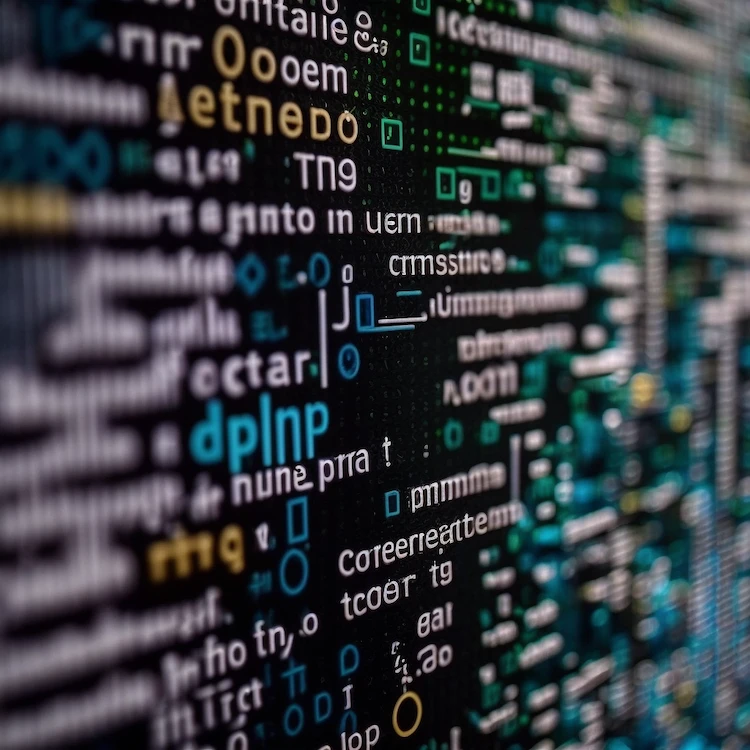
Part 2: Large Language Models and Their Development
2.1 Concept of Large Language Models
Building upon the foundational concepts of AI and neural networks, we now turn to large language models. Large language models are a subset of AI models designed to understand, generate, and manipulate human language. They are trained on enormous volumes of text data, enabling them to learn the statistical structure of a language and apply this knowledge to tasks like text generation, translation, summarization, and more.
One particular type of large language model has been especially impactful – transformer-based models. Transformers, introduced in the 2017 paper “Attention is All You Need”, revolutionized natural language processing (NLP) with their ability to capture long-range dependencies in text data, overcoming limitations of previous architectures like recurrent neural networks (RNNs) and long short-term memory (LSTM) networks.
Among transformer-based models, the Generative Pretrained Transformer (GPT) series developed by OpenAI (which includes models like GPT-3 and GPT-4) have been particularly successful. These models have generated impressive results across a wide range of tasks, sometimes nearing or even surpassing human performance levels.
2.2 Building Blocks of Large Language Models
Underlying the performance of transformer-based models are several key concepts: self-attention, positional encoding, multi-head attention, and the transformer architecture itself.
- Self-attention, also known as the attention mechanism, allows the model to weigh the relevance of each word in a sentence when generating the next word. This mechanism enables the model to understand context and maintain coherence over long passages of text, a skill beautifully demonstrated in Kurdiez’s videos.
- Positional encoding is used to give the model a sense of word order. Since transformers, unlike RNNs and LSTMs, do not process data sequentially, they require positional encoding to recognize the order of words in a sentence.
- Multi-head attention is an extension of the self-attention mechanism. It allows the model to focus on different parts of the sentence for different types of information, adding a layer of complexity and nuance to the model’s understanding of the input.
- The transformer architecture is the framework that combines these elements into a functioning whole. It includes an encoder (which interprets the input text) and a decoder (which generates the output text), though in models like GPT, only the decoder is used.
2.3 Training and Fine-tuning Large Language Models
Training large language models is a two-step process involving pre-training and fine-tuning.
In the pre-training phase, the model learns to predict the next word in a sentence, given the preceding words. This is done using vast amounts of text data, often sourced from the internet. The model is not told anything about the specifics of the task it will be asked to perform later; instead, it learns to understand and generate language by predicting what comes next in the sentences it is trained on. This process is unsupervised because it doesn’t require labeled data.
In the fine-tuning phase, the model is further trained on a smaller, task-specific dataset, often with the help of human annotators. This data is labeled, making this a supervised process. Annotators follow guidelines to rate potential model outputs for a range of example inputs. The model generalizes from this feedback to respond to a wide array of inputs, even ones it hasn’t seen during fine-tuning.
This two-step process is crucial in creating a language model that can generate human-like text. However, it’s worth noting that even the most advanced models, while they can generate impressively fluent and coherent text, do not understand the text in the way humans do. They do not have beliefs, desires, or consciousness; they generate text based on patterns learned during training.
The completion of this part sets the stage for the final section, where we explore the fascinating comparison between AI and the human brain. As Kurdiez’s videos suggest, there’s much to learn and even more to wonder about as we delve deeper into this subject.
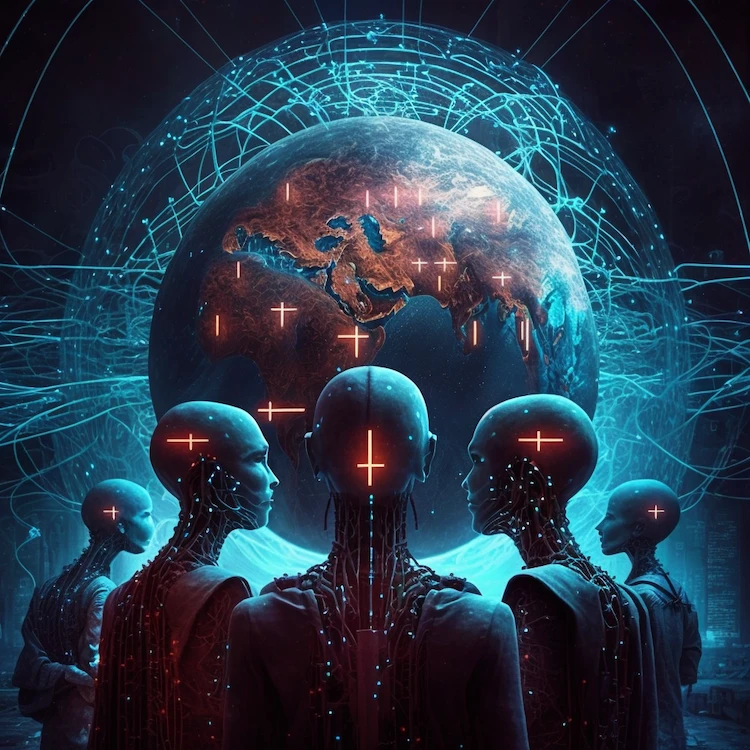
Part 3: AI and the Human Brain: A Comparative Study
3.1 Overview of the Human Brain
While AI and neural networks draw inspiration from the human brain, understanding the full complexity of the brain is a pursuit that remains at the frontier of scientific research. The human brain is a highly interconnected network of approximately 86 billion neurons. Each neuron forms synapses – points of communication – with many others, leading to an intricate web of interconnections.
Neurons communicate through electrochemical signals. When a neuron receives signals from its neighboring neurons, it accumulates this information. If the total signal surpasses a certain threshold, the neuron fires, sending a signal to the neurons it’s connected with. This simple mechanism, replicated across billions of neurons, gives rise to all the complexity of human cognition.
One of the key characteristics of the brain that makes it a powerful learning machine is its neural plasticity – the ability to change and adapt in response to new experiences, information, or injury. This is accomplished through the strengthening or weakening of synapses, the creation of new synapses, or the elimination of existing ones.
The human brain’s learning process is dynamic, adaptive, and based on interactions with the environment. It continuously integrates new experiences with past information, refining its understanding of the world and adjusting behavior accordingly. Contrast this with AI training, which typically happens in defined stages and does not continue adapting once deployed (though this is a subject of ongoing research).
3.2 Comparing AI with the Human Brain
Although AI, particularly deep learning, draws inspiration from the human brain, it’s important to understand that these systems are vastly different in both structure and function.
Adaptability: The human brain is highly adaptable, capable of learning new tasks without needing to undergo a complete “retraining” process. In contrast, while AI models can learn to perform specific tasks with great accuracy, they typically need to be retrained from scratch if the task changes significantly.
Learning Speed: The human brain can often learn from just a few examples, thanks to its ability to generalize and reason. AI, on the other hand, usually requires large amounts of data to learn effectively, although techniques like transfer learning and few-shot learning are narrowing this gap.
Energy Efficiency: The human brain is incredibly energy-efficient, operating on roughly 20 watts of power. AI, especially large-scale models, require significant computational resources and energy, which is a significant challenge for sustainable AI development.
Rigidity vs. Flexibility: AI models are typically good at the tasks they’re trained on but can struggle when presented with tasks outside their training data or when required to transfer their learning to new tasks. The human brain, however, excels in its flexibility, capable of creative thought, abstract reasoning, and adapting to new situations.
3.3 Future of AI: Drawing Inspiration from the Human Brain
In imagining the future of AI, many researchers look to the human brain for inspiration. Understanding how the brain works could provide insights into creating more powerful, efficient, and adaptable AI systems.
Neuroplasticity: If AI could be designed to mimic the brain’s plasticity, it could continually learn and adapt to new information after its initial training, much like how humans learn throughout their lives.
Lifelong Learning: The development of AI systems capable of lifelong learning, similar to the human brain’s ongoing learning process, is a major goal in AI research. This could lead to more adaptable systems that can learn new tasks without forgetting the old ones, a challenge known as “catastrophic forgetting” in AI.
Energy Efficiency: Drawing inspiration from the brain’s energy efficiency could lead to more sustainable AI practices. This could involve developing new hardware architectures inspired by the brain or improving the efficiency of existing algorithms.
Autonomous Decision Making: Current AI systems are still far from matching the human brain’s ability to make complex decisions independently in unpredictable environments. Achieving this capability is a long-term goal for AI research and could lead to more autonomous systems.
In conclusion, the ongoing dialogue between neuroscience and AI research promises to yield fascinating advancements in our understanding of both the human brain and AI. By leveraging the knowledge we gain from studying the brain, we may be able to create more sophisticated and efficient AI systems. And, in turn, AI can serve as a tool to help us unravel the mysteries of the human brain. This bidirectional relationship, which is evident in Kurdiez’s insights, underscores the significance and potential of these interconnected fields of study.

Conclusion: The Interplay of AI and the Human Brain – An Ongoing Odyssey
As we draw our voyage to a close, we emerge not at an end, but at a new beginning – a point of convergence between what we’ve learned and what lies ahead, a juncture filled with both knowledge and curiosity, just as Kurdiez inspires us to embrace.
We began by exploring the ever-evolving landscape of Artificial Intelligence and understanding the intricacies of neural networks that serve as the foundation for most AI systems. We traversed through the enormity of large language models and admired their transformative influence on understanding and generating human language. Each part of our exploration serving as a cornerstone to understanding the breathtaking extent of AI’s capabilities and its potential for future advancements.
Then, we stepped into the magnificent complexity of the human brain, from its billions of interconnections to the phenomenal capacity of human cognition, illuminating the marvelous biology that has inspired so much of AI’s development.
The comparative study between AI and the human brain highlighted stark contrasts and uncanny similarities, showcasing the adaptability and flexibility of the human brain compared to AI’s proficiency within its trained tasks. Yet, this comparison isn’t merely about highlighting differences but exploring possibilities – to reimagine AI with the human brain’s adaptability, lifelong learning, energy efficiency, and autonomous decision-making capabilities.
Our expedition has reaffirmed that AI, much like the human brain, is not static. It’s continually evolving, learning from its past, adapting to its present, and envisioning its future. By learning from the intricacies of the human brain, we can potentially create AI systems that are more powerful, efficient, and adaptable.
And in turn, AI stands as a valuable tool to help unravel the remaining mysteries of the human brain. This symbiotic relationship between AI and neuroscience opens doors to possibilities that stretch the boundaries of our imagination.
In conclusion, as we stand at the frontier of these dynamic fields of study, we’re left with a sense of profound wonder. Our voyage through the realms of AI and the human brain, much like Kurdiez’s insights, emphasizes the ongoing nature of this journey. As we continue to explore, question, and learn, we remain active participants in this thrilling era of discovery, shaping and being shaped by the extraordinary interplay of AI and the human brain.”

Related Content:
Video: Introduction to foundation models on Google Cloud
 YouTube Link: https://youtu.be/YCZ6nwGnL4o
YouTube Link: https://youtu.be/YCZ6nwGnL4o
Video: Introduction to large language models
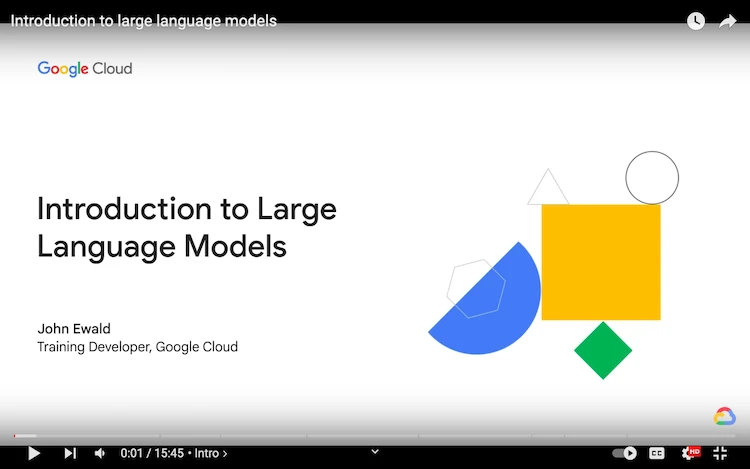 YouTube Link: https://youtu.be/zizonToFXDs
YouTube Link: https://youtu.be/zizonToFXDs
Video: Introduction to Generative AI
YouTube Link: https://youtu.be/G2fqAlgmoPo
Video: Transformers, explained: Understand the model behind GPT, BERT, and T5
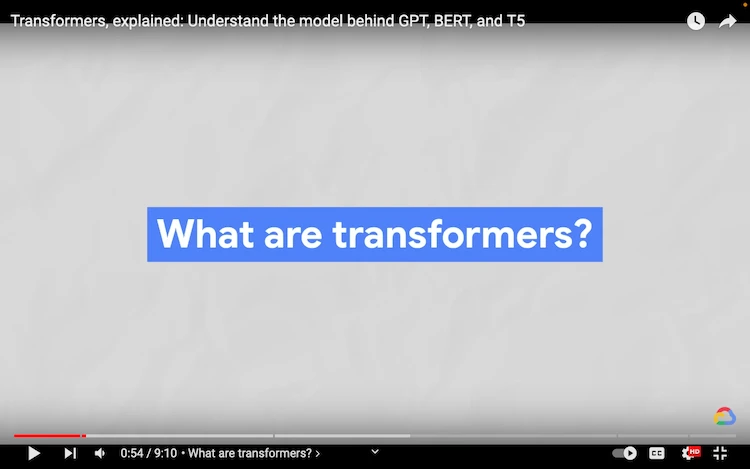 YouTube Link: https://youtu.be/SZorAJ4I-sA
YouTube Link: https://youtu.be/SZorAJ4I-sA
Related books and resources:
“Life 3.0: Being Human in the Age of Artificial Intelligence” by Max Tegmark – A profound exploration of AI’s impact on the future of life on Earth and beyond.
“The Master Algorithm” by Pedro Domingos – Unveils the quest for the ultimate learning algorithm and the implications of a future dominated by it.
“Superintelligence: Paths, Dangers, Strategies” by Nick Bostrom – Investigates the future of AI and the existential risks associated with superintelligent systems.
“How to Create a Mind: The Secret of Human Thought Revealed” by Ray Kurzweil – Merges neuroscience with AI, offering insights into the workings of the human brain and how it can be emulated.
“Deep Learning” by Ian Goodfellow, Yoshua Bengio, and Aaron Courville – A comprehensive resource on deep learning, from foundational concepts to advanced techniques.
“AI Superpowers: China, Silicon Valley, and the New World Order” by Kai-Fu Lee – Discusses the global AI race and the societal changes it might bring.
“Neuroscience: Exploring the Brain” by Mark F. Bear, Barry W. Connors, and Michael A. Paradiso – An in-depth look at the principles of neuroscience, offering a comprehensive understanding of the brain.
“The Future of the Mind” by Michio Kaku – Explores the scientific advancements in understanding the mind and the potential for future technologies.
“Thinking, Fast and Slow” by Daniel Kahneman – A groundbreaking exploration of human thought processes, intuition, and decision-making.
“The Singularity is Near: When Humans Transcend Biology” by Ray Kurzweil – Predicts the future of AI and how it will intersect with human life. To see our Donate Page, click https://skillsgaptrainer.com/donate
To see our Donate Page, click https://skillsgaptrainer.com/donate
To see our Instagram Channel, click https://www.instagram.com/skillsgaptrainer/
To see some of our Udemy Courses, click SGT Udemy Page
To see our YouTube Channel, click https://www.youtube.com/@skillsgaptrainer